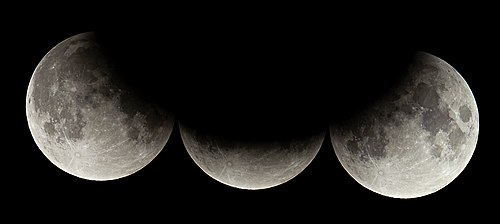Earth shadow

In astronomy and space travel, the earth shadow is the cone of shadow that the earth throws out into space.
The earth's shadow is of great importance for satellite technology and orbit determination because
- Earth satellites become invisible for optical observations when the shadow enters,
- the sun sails then do not supply any energy
- as well as radio shadows can occur
- and the solar radiation pressure is no longer symmetrical over an orbit.
In meteorology , the earth's shadow causes the air temperature to drop at night . When measuring radiosonde ascents in the evening, it has a similarly limiting effect as when eclipsing earth satellites. The projection of the earth's shadow can be seen as an arc of the earth's shadow at twilight on the opposite horizon below the (upper) counter- twilight phenomena .
In astronomy , the earth's shadow is generally not visible, except during a lunar eclipse . Similar shadow phenomena can also be observed - much more frequently - at the moons of Jupiter .
The shadow cast by the earth depends not only on its size, but also on its distance from the sun; therefore it shows slight changes over the course of a year. The length of this cast cone of umbra averages about 1,384,000 km, that is several times the distance of the moon from the earth. Even at the greatest distance from the earth - with an apogee of almost 0.407 million kilometers - the moon can still completely immerse itself in the core area of the earth's shadow ( total umbra eclipse ). The Lagrange point L 2 , however, lies outside the umbra area. A length cannot be specified for the penumbra of the earth.
Individual evidence
- ↑ Robin M. Green: Spherical astronomy , Cambridge University Press, Cambridge 1985, ISBN 0-521-31779-7 , p. 440 (English)
